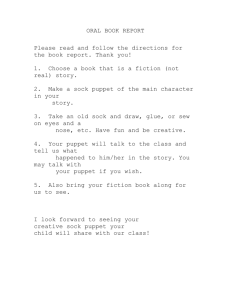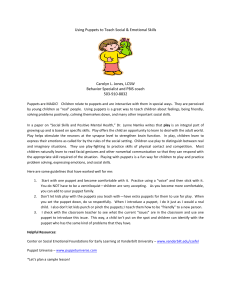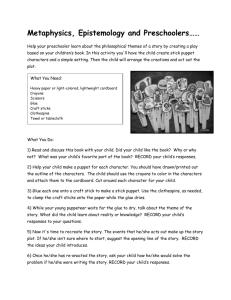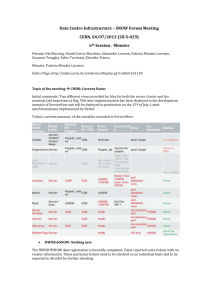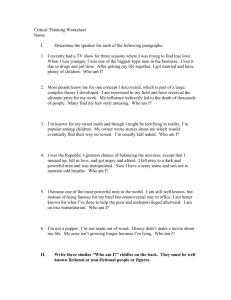Objects of Humour: The Puppet as Comic Performer
advertisement
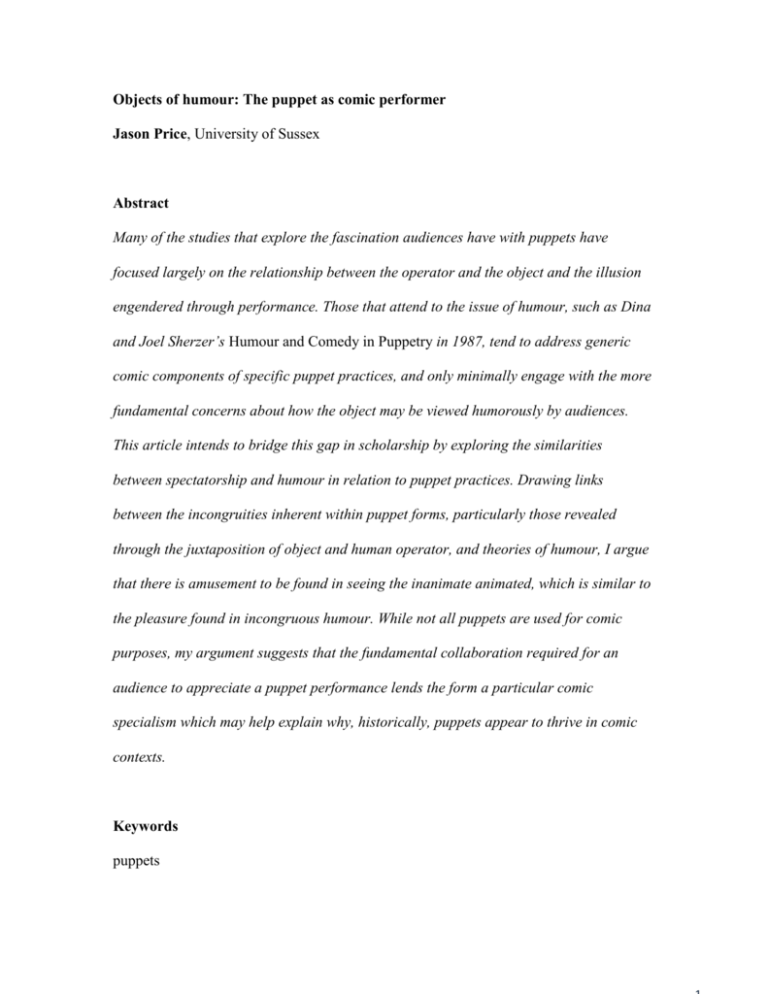
Objects of humour: The puppet as comic performer Jason Price, University of Sussex Abstract Many of the studies that explore the fascination audiences have with puppets have focused largely on the relationship between the operator and the object and the illusion engendered through performance. Those that attend to the issue of humour, such as Dina and Joel Sherzer’s Humour and Comedy in Puppetry in 1987, tend to address generic comic components of specific puppet practices, and only minimally engage with the more fundamental concerns about how the object may be viewed humorously by audiences. This article intends to bridge this gap in scholarship by exploring the similarities between spectatorship and humour in relation to puppet practices. Drawing links between the incongruities inherent within puppet forms, particularly those revealed through the juxtaposition of object and human operator, and theories of humour, I argue that there is amusement to be found in seeing the inanimate animated, which is similar to the pleasure found in incongruous humour. While not all puppets are used for comic purposes, my argument suggests that the fundamental collaboration required for an audience to appreciate a puppet performance lends the form a particular comic specialism which may help explain why, historically, puppets appear to thrive in comic contexts. Keywords puppets puppetry humour comedy incongruity theory Nina Conti Blind Summit Theatre (1) Introduction Scholar Penny Francis (2012: 149) records in Puppetry: A Reader in Theatre Practice that the first recorded instance of a puppet show was in ancient Greece in the third century. We are told that this performance was ‘comic, perhaps satiric, but there would have been an element of low humour, in imitation of [popular] farces [of the period]’ (Francis 2012: 149). The Romans, too, appeared to have enjoyed the comic antics of puppets, and by the early decades of the Common Era they were appearing as stock characters in parodies of Atellan farces. While the spread of Christianity would seriously curtail theatrical activity until the Renaissance, it is generally agreed that puppetry and other forms of popular entertainment continued to be performed underground until that time. By the sixteenth century, the puppet returned to public view in a variety of contexts, but most notably as a companion to the Italian commedia dell’arte, whose zanni gave birth to an array of comic puppet traditions, including Polichinelle (French), Jan Klaassen (Dutch), Punch (English) and Vasilache (Romanian) (Paërl in Francis 2012: 155). Many of these forms continued to be practiced well into the twentieth century, alongside a host of other puppet practices, most notably through vaudeville, variety and stand-up comedy routines. What this whistle-stop tour of historical puppet practices is intended to do is show the longevity of the puppet as a comic agent. One of the striking similarities of many historical studies of puppets, such as Francis’s referenced above, or the more comprehensive studies undertaken by puppet historian Henryk Jurkowski (1996, 1998), for instance, is their attention to the wealth of comic puppet practices that have appeared in a range of historical periods and in diverse cultural contexts. Writings concerned with puppet dramaturgy also tend to highlight their comic potential. One of the more common characteristics identified of comic puppets is their subversive tendencies. As Dina Sherzer and Joel Sherzer (1987: 4) have pointed out, puppets have ‘constantly and dangerously test[ed] the boundaries of the licit and the illicit, the permitted and the unpermitted’. This has given the puppet a unique comic license for satirizing and parodying the powerful, which Steve Tillis explains is the most common application of puppetry in the West (1992: 36). This apparent bias towards the comic also appears in scholarship concerned with the relationship between audiences and puppets. Aesthetician Otakar Zich, for instance, observed that audiences tend to perceive puppets in two ways, comic and mysterious. In the comic mode, humour is identified by audiences in what appears to be the object’s insistence on being accepted as alive, despite our awareness they are not (in Tillis 1992: 54). In the mysterious mode, we become entranced by the illusion that is performed, i.e., that the inanimate appears to possess a life force of its own. As puppeteer and theorist Marjorie Batchelder (1947: 88) observed, it is the dual perceptual modality facilitated in large part by juxtaposing the puppet’s inherent incongruities, such as animate/inanimate, human/object, that may partially explain the puppet’s appeal. As Tillis (1992: 64) has argued, we tend to find these perceptual challenges pleasurable. Based on current scholarship, it seems clear that puppets hold considerable comic expertise. They appear to possess certain characteristics that we inherently find amusing, as well as a likeability and non-threatening nature that enable them to do and say things that we are not socially permitted to do. But why there appears to be a historical bias towards the comic in puppetry is rarely questioned by scholars. Rather, most puppet scholarship is concerned with the fundamental relationship between the audience and object. Where the comic has been treated, such as in the Sherzers’ study (1987) it has been done so primarily in terms of genre and form. These works are often focused on the comic techniques of specific puppet traditions, such as Punch-and-Judy or Wayang Kulit. Seldom is there a crossover between these two approaches. More striking is the absence of research that examines comic puppet traditions alongside theories of humour. The analysis that follows has been formulated as an initial response to these noticeable absences in puppet scholarship. This article seeks to question the comic potential of the puppet form at a fundamental level. In the next section I contextualize my study by outlining connections between the incongruity theory of humour and what Tillis (1992) has referred to as the ‘double vision’ involved in puppet spectatorship. Tillis’s theory suggests that audiences cognitively oscillate between the natural incongruities found by observing the puppet in performance, such as ‘animate/inanimate’ discussed earlier, leading to a pleasurable perception of the object and the belief in its temporary, fictional life. Drawing on a series of basic level incongruities found in puppets identified by Sherzer and Sherzer (1987), I go on to analyse in the final section two contemporary practical examples, drawing connections between the perceptual processes involved in general humour and in viewing puppet performances. Through my analysis I show how attention to, and often exposing, the puppet’s natural incongruities in performances maximizes its latent comic ability. (2) The pleasure of the puppet The illusion of life that a puppet is able to conjure in performance is a consequence of its semiotics, which share the three basic signs that normally signify life: i.e., design, movement and speech. In theory, an object consisting of what we recognize to be a body with moving limbs and the capability (or illusion of) speech may be regarded, when activated, as possessing a kind of life. It is important to recognize, however, that although we may perceive of an object possessing these signs as resembling a living thing/being, we are not likely to mistake it as actually being alive. Even though we may submit to the illusion and engage, and even enjoy, its fictions, most will recognize that the life force the object appears to possess is artificial. In other words: while we may accept the invitation to take part in the puppet’s illusion, we never forget that the puppet is also an object. In viewing a puppet performance, then, we process both the illusion and its mechanics at the same time. But it is not simply the illusion of life in an animated object that explains its appeal for audiences. After all, if we were simply amused by the presence of life, we could (and do) find more convincing life-like portrayals in other forms of entertainment, such as in the theatre or on film. Further, a tendency towards a thorough illusion of life would suggest that we are conditioned to prefer more realistic presentations of puppetry to more abstract forms. However, this does not appear to be the case. Rather, the most popular forms of puppetry practiced at the present time are what famed puppet scholar Roman Paska refers to as ‘primitivist’, which he explains ‘focus on presentation, treating the object as independent objects, sacred or otherwise’ ([1990] 2012: 138, original emphasis). The other principal form of puppetry identified by Paska is ‘illusory’, which is concerned with representation and engendering a convincing illusion ([1990] 2012: 138). Unlike illusory forms, primitivist puppets tend not to disguise their makeup (i.e., material) or their means of operation. For Paska, primitivist forms of puppetry are openly ‘confrontational’ in the ways they display the ‘interaction between performer and object’ ([1990] 2012: 139), which is also extended to the audience and the ways that this display challenges perceptual modes. As Paska observes: Primitivism differs from illusionism in consciously directing audience focus back and forth between the outward sign and the inner process of simulation. And the primitive puppet is flagrantly exhibitionist in exposing its own emptiness as a vehicle for expression in performance. (Paska [1990] 2012: 139) Primitivist forms populate popular culture in the twenty-first century. Indeed, many of us will have encountered primitive puppet performances, e.g. the musical Avenue Q, the Muppets or the National Theatre’s production of War Horse. The ventriloquist and Bunraku acts discussed in the latter part of this article are also primitivist, in which their means of operation are completely or partially exposed and in which their objectness, or ‘emptiness’ in Paska’s terms, is exploited for comic effect. While Paska’s categories are useful for us here so as to be able to classify different kinds of puppet work, it is important to clarify one point about them. With such a clear distinction made between forms that traffic in realistic illusion and those that resist doing so, readers would be forgiven for thinking the two puppet forms might offer quite different viewing experiences. It is important to recognize that this is not the case. No matter how convincing the illusion appears to be, the spectator will still be confronted with the puppet’s object-ness, as well as the presence of an outside life-force (e.g. the handler). In his essay ‘The actor occluded’ Tillis (1996: 115) explains that no matter how thorough the illusion ‘the puppet invariably exposes the presence of the operator behind it, even if it occludes that presence by taking focus as the site of the operator’s performance’. So while barriers to accepting the illusion might be minimized in certain illusory practices, they are still very much present; audiences at illusory puppet performances will still be faced with juxtaposing the real with the imaginary. This juxtaposition appears to be central to puppet spectatorship and in part distinguishes it from viewing other kinds of performances. It is not exactly understood how we balance these incongruities when watching a performance, but it is clear by the success of puppetry as an art form that we are able to do so and, importantly, appear to enjoy doing so. There have been many theories regarding how this process works, but the most convincing seems to be Tillis’s concept of ‘double-vision’, which posits the spectator sees/perceives the object as object and character at once (1992: 64). For Jurkowski, this ‘double recognition’ causes the spectator to ‘oscillate’ between the elements, which might explain how we can invest so firmly in the illusion we overlook, temporarily, the reality of the object. For Tillis, the process is simultaneous, ‘[s]timulat[ing] a certain amount of pleasure by challenging its audience to consider the ontology of an “object” with “life”’ (1992: 66, emphasis added). In this way the puppet’s appeal appears to be connected to, as Batchelder observed earlier, the perceptual juxtaposition between inanimate object and the illusion of life. It is the recognition of the dual appeal of the performed puppet that I suggest shares certain connections to the incongruity theory of humour. In way of review: incongruity theory explains that one often finds something humorous when two objects not typically aligned are.1 As John Morreall explains in Comic Relief: A Comprehensive Philosophy of Humour, incongruity theory is based on the fact that human experience works with learned patterns. What we have experienced prepares us to deal with what we will experience […] Most of the time, most experiences follow such mental patterns. The future turns out like the past. But sometimes we perceive or imagine a thing whose parts or features violate our mental patterns. (2009: 10–11) For Morreall this violation is known as a ‘cognitive shift’, which operates like the ‘set-up and punch’ in a traditional joke. ‘The set up’, he explains, ‘is our background pattern of thoughts and attitudes’, whereas ‘[t]he punch is what causes our thoughts and attitudes to change quickly’ (Morreall 2009: 50). It is the oddness or perceived absurdity of the misalignment that may produce laughter in the spectator. In relation to puppetry, one might see the inanimate puppet body as the ‘set up’. In its inanimate state, we may register similarities between the object body and a human one, but we understand the object is not capable of life. Animation, therefore, operates as ‘the punch’. During this process the object assumes a life force that we know it is not capable of independently, thus violating our mental patterns resulting in pleasure that may result in humour. In this regard, puppet spectatorship and incongruous humour can be seen as operating in similar ways. At its most fundamental, a puppet invites audiences to read signs typically signifying life in an object that has none. Beyond this, the puppet has little choice but to constantly remind readers of its objectness through performance, either metatheatrically by calling attention to its materiality as a comic technique, a point which I will return to later, or through the constant conflation of its object ‘body’ with the living body of its operator. Whilst juxtaposing the reality of the (inanimate) object with the illusion of life in itself may not provoke laughter, our review of puppet scholarship indicates that something about this duality forms part of the appeal of the puppet form for many spectators. The rest of this article will focus on evaluating the comic potential of the incongruities found in the puppet in relation to two contemporary examples: the work of British ventriloquist Nina Conti and Blind Summit Theatre. These examples have been chosen because of their popularity and the accessibility of examples of their work, but it is my belief that many of the conclusions reached may be applied to puppet practices more broadly. Keeping a firm eye on the perceptual processes involved in reading incongruous humour and puppetry more generally, I aim to show how practitioners have learned to capitalize on the incongruities inherent within the puppet and that attending to those in performance enhances the comic possibilities of the form. (3) The comic/puppet in performance For Sherzer and Sherzer (1987: 4) the puppet offers a ‘web of interesting incongruities’ which they argue are ‘central to puppet play and comedy’. This ‘web’ consists of the following typical examples: Big/small Animate/inanimate Human/object Talking/non-talking or talked for Adult/child Having high volume/flat Serious/humorous. (Sherzer and Sherzer 1987: 4) This list is, of course, only indicative, but it provides a useful starting point. There are areas of overlap and some absences in this ‘web’, however, that we must attend to before we can begin to use them as tools for analysis. Firstly, ‘big/small’ is used by the Sherzers to refer to the contrasting size of operators and their puppets, with the assumption being that the operator is large and the puppet is small. There are times, however, where the contrast in size is less severe and others were it is completely reversed. In the former category, I am reminded of Conti’s puppet Granny, which, standing around a metre high, is over half Conti’s size. We are not likely to read Granny in the same way we will read Monk, a toy hand puppet monkey, who is less than half Granny’s size. In the case of Peter Schumann’s large-scale puppets for The Bread and Puppet Theatre, the ‘big/small’ dichotomy is completely reversed and it is the puppet that overpowers, visually, the operator(s). Hence, ‘big/small’ and what it suggests is only appropriate in certain contexts. For this reason, I have elected to do away with the ‘big/small’ category. Instead, I will refer to these differences as incongruities of size, which is intended to cover a broader range of practices. The ‘adult/child’ dichotomy is very much related to the puppet’s size, although it does raise an important point not explicitly covered by the size category as defined above. The relationship between puppet and ‘child’ more generally is related to a particular area of discourse surrounding puppet reception. For scholars such as Paul McPharlin (1938), for instance, part of the puppet’s appeal can be explained by its similarities to children’s toy dolls. For McPharlin, we are drawn to the puppet because it gives us access to sensations we may have experienced when playing with dolls as children. Whilst some scholars, including Tillis, have rejected this theory, there does appear to be some validity to it, as scholar Melissa Trimingham’s recent work on cognition and puppetry has shown. She explains that ‘a miniature physical object reminds us of a child-like level of operating in the world that we have forgotten but which comforts us with its familiarity’ (Trimingham n.d.: 7). Trimingham’s application of the word ‘miniature’ is revealing and supports my point that the ‘adult/child’ dichotomy is too closely related to ‘big/small’, or simply size, to warrant a separate category. Thus, when I refer to incongruities of size, I acknowledge the connection to childhood where it seems appropriate to do so. Although as the discussion of size has shown, it is difficult to generalize about all puppet forms. Not all puppets are small; not all small puppets are child-like. One must consider the broader contexts around the object before applying these categories. The human/object and animate/inanimate dichotomies have been referred to throughout this article, but it will be useful to provide some clarification here, too. First, ‘human/object’ seems to me the most fundamental of all puppet incongruities, as through juxtaposing these realities the object’s materiality is exposed. This can be revealed by even the most superficial analysis and without the object even necessarily being animated. But it is true that this dichotomy is more fully apparent when the object is engaged in the act of performance, as this is where a full sense of its materiality may be revealed. This means the ‘human/object’ category is closely connected to ‘animate/inanimate’. Nevertheless, in keeping with my simplification of the Sherzers’ categories, and as it is the contrast in materials that becomes most apparent when the human operator and object are considered together, I will refer to this category as incongruities of materials in the analysis that follows. The final category that I will give serious attention to in this article is ‘animate/inanimate’, which, like materials, seems one of the more fundamental at work in puppet practices. But the terms themselves have shown to be problematic, so we will need to reconsider their use here. As Tillis (1992: 18) has pointed out, there are cases where the object that is animated already possesses a life force of its own independent to its role as puppet character, such as the hand puppets of celebrated puppeteer Sergei Obraztsov. In such works, the object is thus not inanimate; it actually belongs to a living body. But it does, as Tillis suggests, appear to ‘live apart’ from the living body it is connected to. For these reasons, I will discuss the ‘animate/inanimate’ category as the incongruities of life. With the exception of ‘Talking/non-talking or talked for’, which quite clearly belongs to the life category, the other entries in the Sherzers’ ‘web’, such as ‘high culture/folk’, ‘having high volume/flat’, ‘serious/humorous’ and ‘contrasting languages, registers, styles, dialects and non-verbal gestures’ (1987: 4) are either specific comic devices not necessarily exclusive to the puppet form or simply beyond the scope of this study. For these reasons, they have been put aside for the time being. Incongruities of size Despite Tillis’s concerns with the ‘doll theory’, there appears to be some relevance to the idea that certain kinds of puppets, when they are smaller than their operator, can appear child-like to audiences, as Trimingham’s research into cognition demonstrates. For her, it is not simply their size but their limited range of movement that provokes us to read them as ‘child-like’ (Trimingham n.d.: 9). She does not deny that puppets can be ‘emotionally engaging characters’, but she explains that ‘our sympathy may be rooted in the nature of the physical gestures they are able to make, which ultimately are always child-like’ (Trimingham n.d.: 9). This is what Kenneth Gross (2010: 407) refers to when he writes about how puppetry ‘creates an audience tied together by child-like if not childish things’. Providing one is not averse to children, it seems reasonable to assume that one might find amusement in objects that operates like them. Conti and her puppet Monk present a good example of this. An adult female in conversation with a small toy monkey already suggests an amusing comic scene. Beyond this most basic visual stimulus, Conti and Monk then proceed to invite the audience to identify and misidentify with Monk as a toy (or ‘doll’) in several ways. The first is by very carefully playing against the obvious power relations suggested by their size, as well as what the audience understands about the mechanics of ventriloquism, i.e. that Conti is controlling the illusion. The result of this is that Monk often appears as the leading comic force in their performances. In the 2007 show Complete and Utter Conti this reversal of power relations is demonstrated early in the performance when Monk refuses to deliver the punch lines to jokes correctly. The following exchange is indicative of this. Conti: Why did the monkey fall out of the tree? Monk: Because he was dead. (Dryly) Ha. Ha. Fuck you. (Conti 2007: n.p.) As the act develops, Monk’s insistence upon being in charge becomes more direct as he claims to ‘carry the act’ and that he wants to perform in his own show. When Conti asks where she would be in his show, Monk sly remarks ‘under a table’, reducing the value of Conti’s role in the act as that of mere operator, as opposed to crucial player. This role reversal, which plays on the power relations suggested by the differences in size and in material, is a common characteristic in puppetry, particularly ventriloquism. Famous British ventriloquist Arthur Worsley’s act with his outspoken puppet Charlie Brown was completely developed on this reversal, and it was Worsley who was generally regarded to be the ‘dummy’ of the act. It is clear that this role reversal contradicts that which is suggested by their size. How this operates humorously is similar to ‘the set up and the punch’ of the traditional joke, discussed earlier. The ‘set up’ is reading the operator as being larger and subsequently more powerful than the object. The ‘punch’ occurs when the puppet appears to take charge of the act therefore reversing the relationship. The irony, of course, is that the operator remains in control throughout, so the humour is firmly connected to the illusion engendered by the performance. This does not mean, of course, that in accepting the invitation to buy into the illusion we forget about the object and its materiality; ‘double-vision’ enables us to attend to both. Our knowledge that we are being led to believe that the object is in charge is yet another incongruity, i.e., ‘illusion/reality’, that likely contributes to the reversal’s humour. But the very act of resistance performed by the object is also child-like in certain ways. Here I am reminded of Zich’s comments (in Proschan 1987: 34) regarding the ‘subtle humour’ that accompanies the object’s insistence upon being accepted as ‘real’. This is particularly compounded in Conti’s case by the fact that Monk is, in fact, a child’s toy. However, this, too, is played with in Conti’s performances. Whilst a toy may very well invite a child-like reading, Monk resists such typing through his particularly foul language. For instance, early in Complete and Utter Conti, Monk asks Nina: ‘[Does the audience] know they are paying good money to see a monkey fisted on stage?’ (Conti 2007: n.p.). It is the object’s association with children as a child’s toy that makes such phrases disturbing; and it is the severe contrast between the object and its association and the very un-child-like things that come out of its mouth that make such moments funny. This may also help explain how the puppet seems to be able to push the boundaries of what we see as socially acceptable so much further than we can. It is their implied innocence through our fundamental reading of small puppets as child-like that allows us to forgive them for crossing these boundaries. It is the realization, too, of the fiction of their presence – through double-vision – which probably extends our ability to tolerate and even find humour in their boundary pushing – much more so, in fact, than we probably would do if it was an actual child. While the fundamental differences between the size of the operator and object may not present a sufficient incongruity to facilitate humour, once the implications of the contrasting sizes are openly played with or completely reconfigured in the performance, it becomes humorous. This includes our perceptions of puppets as being child-like and how this is incongruous with the powerful positions they assume and the social boundaries they seem to enjoy transgressing. As I have argued here, this exploration and the reversal of power relations also draws on the audience’s understanding of puppet conventions – i.e., that the puppeteer, despite the illusion, remains in charge, which is likely to exacerbate the comic potential of such moments in performance. Incongruities of materials and life Early into the performance Complete and Utter Conti, Monk becomes distracted by his hand, which has gotten stuck to his leg. He asks for Nina’s help to free it. Monk explains to the audience that his hand has Velcro on it, which is the cause of this particular dilemma. Once his hand has been freed, Monk says ‘ouch’, resulting an audible ‘awww’ from the audience. The incident with the Velcro makes Monk question his materiality and subsequently his very existence: Monk: Am I real monkey? Conti: Yes you are. Monk: I don’t understand the Velcro. Conti: Don’t worry about it. Monk: And I’ve got a tag on my ass that says ‘Made in Taiwan’. (Conti 2007: n.p.) This exchange is an example of how the incongruities of the object’s materiality and its apparent life are played against each other for comic effect in performance. Even when its materiality is brought quite clearly into focus through a discussion of its Velcro hands, the audience feels sympathy for the toy monkey puppet when it responds in a human way (e.g., ‘ouch’). It also demonstrates a point I raised earlier about how these incongruous categories operate together, as here the object’s materiality is brought into focus through the act of animation. Let’s begin by attending to the material concerns. On the most basic level, one of the first differences likely to be apparent to the audience in addition to the contrasting sizes of the operator(s) and their puppets will be their make-up. For consistency, let’s review the differences between Conti and Monk: Conti is a human adult in her early 40s, Monk is a small, brown, furry toy monkey. Whilst these differences are striking, they are probably not enough on their own to engender a comic response. If these differences were sufficient, many of us would find adults handling children’s toys humorous, which is clearly not always the case. Where this has the potential for humour is through the act of performance where direct comparisons between the two ‘living’ bodies can be made more easily. Thus it is not simply the contrasting materials but the contrasting materials as they work together where humour will most likely manifest. In performance, the material differences between operator and object can, and often do, serve as a source of metatheatrical humour. As Monk calls attention to his materiality in the exchange above, we are forced to confront the reality of his/its situation. Where his design, movement and speech suggest to us he is living – a fact compounded by Conti’s virtuosity as a ventriloquist, his Velcro hand and ‘Made in Taiwan’ label are incongruous with those signs. Monk further confuses these categories in Conti’s 2008 show Evolution by suggesting that he is the product of a one night stand between actor Sean Connery, from which he obtained his Scottish accent, and an oven glove, from which he obtained his glove interior. In this sequence Monk exposes both his materiality and the human effort required to make him ‘live’. Even though we view in double-vision and thus never fully forget the object’s materiality, having it prioritized so clearly in this way forces us to juxtapose its material reality with its artificial life. We find humour in this situation because it is incongruous with the illusion we invest our imaginations in. To put more succinctly, drawing attention to the object’s materiality in this way seems at odds with the fundamental goals of the performance and the expert skill of the operators, which is to convince us of the legitimacy of the illusion they make. Once again, our expectations – i.e., that we buy into an illusion – are thwarted by the very instrument designed to engender it, thus possibly resulting in humour. Another interesting example through which to explore these incongruities is Blind Summit Theatre’s The Table (2012), which features Moses, a two-foot tall ‘three-man operated, Japanese bunraku-style table-top puppet with interchangeable parts’ consisting of a large cardboard head and fabric body. He promises an evening of ‘epic puppetry’ that will primarily consist of him performing, ‘in real time’, the last ‘twelve hours of Moses’ life’ from the Bible on top of rather ordinary table (Blind Summit Theatre 2012: n.p.). But this never materializes. Instead, Moses becomes preoccupied with explaining how he is operated and what his life is like on his table, which he claims has been his home for nearly 40 years. Throughout the course of the performance, he shows us his favourite parts of the table; where he likes to ‘sun’ himself; and how many steps it takes him to get from corner to corner. The fiction he produces is completely based on exposing the mechanics behind his operation and, simultaneously, to make us participate in the making of his imaginary, theatrical world. He so thoroughly convinces us of the legitimacy of his world that when a human female sits down at the table to read a book as part of the performance, the effect is jarring. This is despite the fact that Moses has engaged routinely throughout the performance with his operators. My suspicion as to why we read the operators differently to the female is that whilst they work together to form the existential ‘character’ Moses, the performer is as much a ‘fiction’ as the puppet character. Because of this, this conflation of puppet and human seems to invite a direct confrontation between our imaginations and our own materiality. The conflation of a puppet that so openly exploits its own make up and artifice with the unexplained physical presence of the human body seems to raise questions about our own materiality and the fragility of our human lives. It is as if Moses’ existential concerns are transferred on to the body and subsequently on to us, the audience. The effect is reminiscent of what Gross has observed in writing about the puppet theatre: The puppet serves as an ambassador or pilgrim to human beings from the world of things. The puppet reminds us of our powers of animation. It can also remind us (by contrast) of our tendency to turn ourselves – our words, our thoughts, our feelings –into fixed, inanimate things. (2009: 187) Like with Monk calling attention to his own materiality, Moses’ entire existence is based on firmly acknowledging – and exploiting – the mechanisms through which he appears to be made alive. While this does offer many humorous moments throughout, it also raises questions for audiences regarding their own materiality and the way we process illusion. Ultimately, as has been discussed, we find such challenges pleasurable – and even where such challenges are not articulated as cleverly or exploited as openly as they are with Conti’s work or in The Table – we understand and find pleasure in processing the contradictions invoked by the puppet in performance. (4) Conclusions Combined, these three inherent incongruities – size, materiality and life – seem to be the foundations on which at least these comic puppet performances have been created. Whether reversing the power relations suggested by the contrast in operator and puppet sizes, placing crude text in the mouth of something we view as child-like, exposing the materiality of the object and thereby contradicting the illusion, or simply questioning the illusion itself, exploit the conventions of the form and the incongruities within it for comic effect. My view is that somewhere within this tangled web of incongruities, we may find some reasons for the puppet’s longevity and what I suggest is an inherent comic specialism. Whilst my analysis focuses purely on contemporary ventriloquism and Bunraku-style performances, some of the conclusions drawn may very well be applied more broadly. As I have warned, however, these conclusions cannot be applied to all puppet practices. The convention of a puppet form, like comedy, has its own social context and where certain incongruities may be read humorously in some, they most certainly will not in others. But questions remain about the more subtle effects of these incongruities on the way that we read puppet performance. While processing the illusion does not seem to be challenging to spectators, Zich’s work has demonstrated that when not processed humorously puppet performances tend to be read as ‘mysterious’ by audiences. There is a need, therefore, to question this dual modality and, in terms of comedy, to better understand how this more mysterious reading affects the comic potential of a work. Questions remain, too, about digital animation and ‘avateering’, new modes of puppetry and object/digital body manipulation and the incongruities they offer, which, to be sure, are very different to the more traditional forms explored here. References Batchelder, Marjorie (1947), Rod-Puppets and the Human Theatre, Columbus, OH: Ohio State University Press. Blind Summit Theatre (2012), The Table, London: Soho Theatre, 21 January. Conti, Nina (2007), Complete and Utter Conti, London: Mike Perrin For Just For Laughs Live. Foley, Sean (2008), Evolution, London: Mike Perrin For Just For Laughs Live. Francis, Penny (2012), ‘History’, Puppetry: A Reader in Theatre Practice, Basingstoke, Hampshire: Palgrave Macmillan, pp. 145-177. Gross, Kenneth (2009), ‘The madness of puppets’, The Hopkins Review, 2:2, Spring, pp. 182–205. Jurkowski, Henryk (1996), A History of European Puppetry, vol. 1, Lewiston, NY: Edwin Mellen Press. ____ (1998), A History of European Puppetry, vol. 2, Lewiston, NY: Edwin Mellen Press. Martin, Mike W. (1983), ‘Humour and aesthetic enjoyment of incongruities’, British Journal of Aesthetics, 23:1, pp. 74–85. McPharlin, Paul (1938), Aesthetics of the puppet revival, Master’s thesis, Detroit, MI: Wayne State University. Morreall, John (2009), Comic Relief: A Comprehensive Philosophy of Humour, Chichester: John Wiley and Sons. Paska, Roman ([1990] 2012), ‘Notes on puppet primitives and the future of an illusion’, in Penny Francis (ed.), Puppetry: A Reader in Theatre Practice, Basingstoke, Hampshire: Palgrave Macmillan, pp. 136–40. Proschan, Frank (1987), ‘The co-creation of the comic in puppet theatre’, in Dina Sherzer and Joel Sherzer (eds), Humour and Comedy and Puppetry: Celebration in Popular Culture, Bowling Green, OH: Bowling Green Popular Press, pp. 30–46. Sherzer, Dina and Sherzer, Joel (1987), ‘Introduction’, in Dina Sherzer and Joel Sherzer (eds), Humour and Comedy and Puppetry: Celebration in Popular Culture, Bowling Green, OH: Bowling Green Popular Press, pp. 1–7. Tillis, Steve (1992), Toward and Aesthetic of the Puppet: Puppetry as a Theatrical Art, New York: Greenwood Press. ____ (1996), ‘The puppet occluded: Puppet theatre and acting theory’, Theatre Topics, 6:2, pp. 109–19. Trimingham, Melissa (in press), ‘How to think puppet’, Forum Modernes Theatre. (Accepted for publication October 2012). Zamir, Tzachi (2010), ‘Puppets’, Critical Enquiry, 36:3, pp. 386–409. Contributor details Jason is a lecturer in Contemporary Theatre and Performance at Sussex University, where he teaches courses in political performance, directing and theatre making. He has published and presented widely on the topics of popular and community performances, with recent work appearing Contemporary Theatre Review, Popular Entertainment Studies and Studies in Theatre & Performance. His book Popular Theatres is due out next year. Contact: Dr Jason Price School of English Arts B, 218 University of Sussex Brighton, Falmer BN1 9QN E-mail: J.Price@sussex.ac.uk

